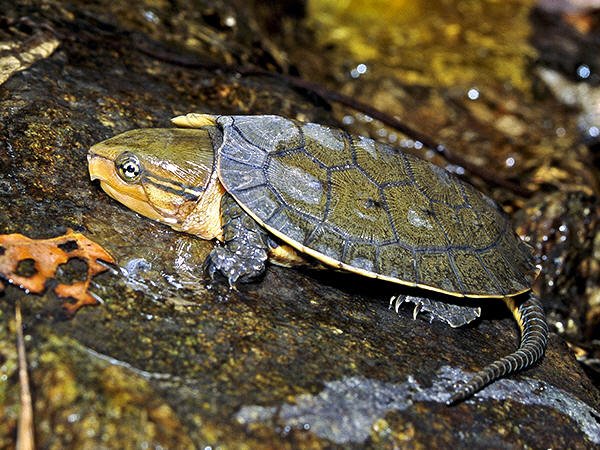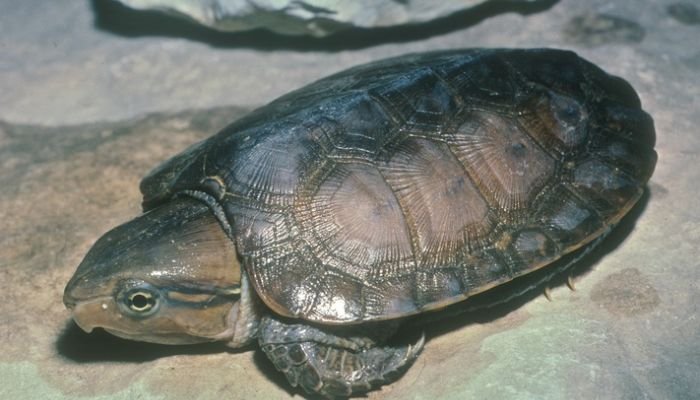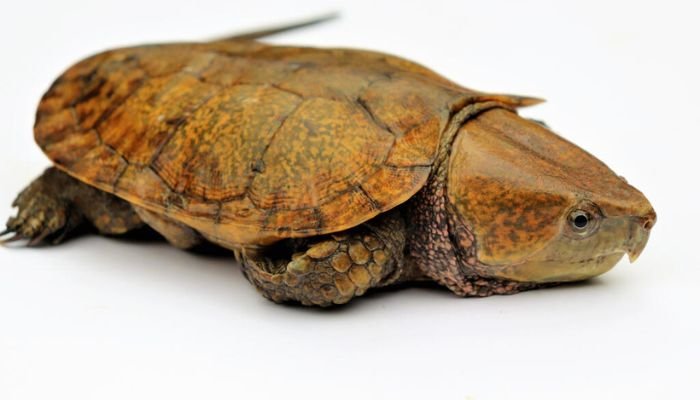
The big-headed turtle, or Platysternon megacephalum as it’s formally known, is a threatened species endemic to Southeast Asia. The name of these reptiles alludes to the fact that their heads are significantly larger than the rest of their bodies. They have good swimming skills and prefer to inhabit freshwater habitats. The Big-Headed Turtle consumes a wide variety of food, including aquatic invertebrates, small fish, and plant matter. Their one-of-a-kind style and mysterious nature have made them celebrities.. Here are Big-headed turtle Guide on Food, Habitat, Size, Lifespan & Predators below-
Big-headed turtle Stats in Table format
The stats are given below for the Big-headed turtle
| Reptiles List | Big-headed turtle |
|---|---|
| Family | Platysternidae |
| Type | Turtle |
| Size | Small |
| Length | Big-headed turtle: Up to 5-7 inches (13-18 cm) |
| Color | Big-headed turtle: Usually has a dark brown or black coloration. |
| Weight | Big-headed turtle: Can weigh up to 2 to 4 pounds.. |
| Lifespan | 30-40 years (or more) |
| Reproduction | Oviparous, lays eggs |
| Gestation Periods | The incubation period for the eggs of the Big-headed turtle is approximately 70 to 90 days, but it can vary depending on factors such as temperature and humidity |
| Endangered Status | Vulnerable (IUCN Red List) |
| Features | Large head, strong jaws |
| Country & Areas | China, Laos, Vietnam, Cambodia, Thailand, Myanmar, Malaysia, Indonesia, Singapore, Brunei, Philippines, and possibly Bangladesh and India. |
Big-headed Turtle Habitat and Distribution
Platysternon megacephalum, more often known as the Big-headed Turtle, is a species of turtle that may be found across much of Southeast Asia. Originating in the southern part of China, it has since spread to northeastern India, Thailand, Laos, Cambodia, Vietnam, and the Malaysian peninsula. Rivers, streams, and wetlands in tropical and subtropical forests are ideal habitats for these turtles. In their ideal habitats, there is plenty of varied food sources and safe places to sleep.
Big-headed TurtlePhysical Features and Adaptations
Here are some information about Big-headed Turtle:
1. Body Structure
Among turtles, the Big-headed Turtle stands out for its unusual appearance. The name comes from the animal’s disproportionately huge head compared to the rest of its body. Because of this versatility, it is able to successfully hunt and consume a wide variety of foods. The turtle’s modest size and gently domed shell make it ideal for navigating the seafloor’s abundant marine life. It can swim efficiently because to its webbed feet and climb and dig with its keen claws.

2. Coloration and Patterns
The Big-headed Turtle’s patterning of color is stunning. Its carapace (top shell) is covered with elaborate patterns and markings in brown, black, and olive tones that help it blend in with its surroundings and evade notice. Bottom shells, or plastrons, are often a pale yellow or creamy tint.
3. Defense Mechanisms
The Big-headed Turtle might use a variety of defensive strategies. The turtle accomplishes this in part by burying its head inside its shell. If it ever feels surrounded or threatened, it can utilize its sharp claws and formidable fangs to deliver a fatal bite. The turtle may release a foul odor when threatened in order to warn away predators.
Big-headed Turtle Diet and Feeding Habits
Here are some information about Big-headed Turtle:
1. Diet Type
Use of the Over-the-Head Method of Consumption The turtle has a wide diet, including both plant and animal matter. It doesn’t care what kind of food it is. The turtle can adapt to different environments and dietary needs with relative ease.
2. Preferred Food Sources
Aquatic invertebrates including insects, crabs, and mollusks are a favorite meal of big-headed turtles. Its diet consists primarily of small fish, but it also occasionally consumes bits of plant debris, such as rotting fruit and submerged foliage.
3. Feeding Schedule
Because of their opportunistic feeding habits, big-headed turtles don’t have a set feeding schedule. All day long, in their natural environment, they employ their acute senses to look for and gather food. Food availability is one aspect that may alter how often they eat.
Big-headed Turtle Housing and Enclosure Requirements
Here are some information about Big-headed Turtle:
1. Terrarium Size and Setup
Captive big-headed turtles do best in a well-kept terrarium. The terrarium should be spacious enough to allow the turtles to move about comfortably. The minimum tank size for a single adult Big-headed Turtle is 75 gallons.
2. Substrate Options
The ideal substrate will mimic the turtle’s natural environment in terms of texture and look. The substrate can be either river sand or a mixture of sand and dirt, and the turtles will have plenty of room to dig and burrow into it. It’s also a good idea to add some cover, such rocks or driftwood.
3. Temperature and Lighting
Big-headed turtles can only efficiently metabolize calcium in a warm basking environment with access to ultraviolet (UV) light. 85 to 75 degrees Fahrenheit (29 to 24 degrees Celsius) is the ideal basking temperature range. It is advised that shellfish receive 10 to 12 hours of UVB lighting each day for optimal health and shell growth.
4. Humidity and Water Needs
Water and high humidity are essential for the survival of big-headed turtles. The ideal humidity range for the enclosure is between 60% and 80%. Humidity boxes or routine spraying of the area are two options for doing this. For proper hydration and swimming, the turtles require access to clean, non-chlorinated water.
Big-headed Turtle Behaviour and Temperament
Here are some information about Big-headed Turtle:
1. Activity Levels
It is important to note that the big-headed turtle is a nocturnal creature. They practiced a much to become proficient swimmers. However, they like to sunbathe to keep their internal temperature steady.
2. Social Behaviour
Social interactions between big-headed turtles and other turtle species may occur in the wild. They don’t spend all their time alone, but they don’t interact with others much either.
3. Handling and Taming
Domestication Especially if they were captured in the wild, the number of big-headed turtles maintained as pets should be limited. When provoked, they may resort to biting as a means of self-defense. Because of the risk of injury and long-term behavioral problems, training a turtle is not recommended.
Big-headed Turtle Breeding and Reproduction
Here are some information about Big-headed Turtle:
1. Mating and Courtship Rituals
A Big-Headed Person During the spring and summer, when turtles are mating, they engage in elaborate courtship rituals that make them easy to recognize. When mating, male turtles chase females violently through the water. The wooing behavior may involve subtly head nodding, nibbling, and biting. As part of their courtship ritual, male turtles may use their lengthy claws to scratch the face and neck of a potential mate. It’s been noticed that when it comes to love partners, women are pickier than males.
As soon as a fertile female is located, the mating process begins submerged. While riding on the back of a female, the male employs her powerful claws to anchor himself to her carapace. Due to the lengthy nature of the copulation process, male turtles frequently engage in territorial and access battles over females.
2. Incubation and Hatchlings
After a successful mating, the female Big-headed Turtle would look for a remote land region to lay her eggs and raise her young. Birds that lay eggs typically prefer sandy or loamy soils because they are more forgiving than other types of soil. The female makes a nest (often with two or three eggs) with her hind legs. This species often has a tiny clutch size.
The female lays her eggs in a nest, which she then conceals by covering with earth. The time it takes for an egg to hatch depends on factors including temperature and humidity, but it usually takes between 70 and 110 days. Incubation temperatures in the low to mid-80s Fahrenheit (approximately 30°C) typically produce a mix of male and female chicks.
Baby animals need a special kind of tooth called an egg tooth in order to break open their eggs. Leaving the nest and making their way to the water marks the beginning of the next phase of their aquatic existence.
Big-headed Turtle Common Health Issues and Veterinary Care
Here are some information about Big-headed Turtle:
1. Respiratory Infections
When kept in captivity, Big-headed Turtles are especially vulnerable to respiratory illnesses. Poor husbandry techniques, like limited ventilation, poor water quality, or incorrect temperatures, frequently lead to these diseases. Possible signs of a respiratory infection include a runny nose, wheezing, fatigue, and shortness of breath.
Treatment for respiratory infections in turtles requires a visit to a vet who specializes in reptiles. Antibiotics and other supportive care, as well as an improvement in the turtle’s environment, may be part of the treatment plan.
2. Parasites
Another major threat to Big-headed Turtles’ health is parasitic infections. Weight loss, diarrhea, and general weakness are only some of the symptoms caused by internal parasites like nematodes and cestodes that can impair the turtle’s digestive system. Skin irritation and pain may also be caused by external parasites like mites and ticks.
A veterinarian can find internal parasites by routine feces inspections and then administer the necessary deworming medicine. Parasites on the reptile’s skin can be treated with safe topical medicines or baths.

3. Metabolic Bone Disease
Big-headed Turtles, like many other reptiles, are susceptible to a dietary problem known as metabolic bone disease (MBD). It develops when the body does not get enough calcium, phosphorus, or vitamin D3. Shell weakening, limb abnormalities, and general weakness are all possible outcomes of MBD in turtles.
A healthy diet high in calcium and vitamin D3, as well as adequate exposure to UVB lighting, can help prevent MBD. If a veterinarian determines that your turtle has MBD, treatment options may include dietary changes, calcium supplements, and illumination alterations.
Importance of Regular Vet Check-ups
Whether big-headed turtles are being kept as pets or in a breeding program, they need to have regular checkups with a veterinarian. Since reptiles can hide their pain, they regularly end up in the emergency room. During routine visits, the vet may keep an eye on the turtle’s development and tend to any husbandry concerns that may arise.
The turtle’s health will be assessed by a thorough physical examination by the vet. The veterinarian will also evaluate the turtle’s mobility and breathing. The nutritional status and general health of the turtle can be ascertained through bloodwork and a parasite analysis of a feces sample.
Conclusion:
The Big-headed Turtle is unique among turtles in both look and behavior; it can only be found in Southeast Asia. You should research its native habitat, nutrition, and behavior if you plan to keep one as a pet or participate in the responsible conservation of the species.
FAQs
Q: What is the family and Type of a Big-headed Turtle?
Platysternon megacephalum, sometimes known as the Big-headed Turtle, is a species of turtle belonging to the Platysternidae family.
Q: What is the average size of a Big-headed Turtle?
Big-headed turtles typically measure between 8 and 12 inches (20 and 30 cm) in carapace length.
Q: How long can a Big-headed Turtle grow in size and length?
The usual carapace length of a Big-headed Turtle is between 14 and 16 inches (35 and 40 cm), but there have been reports of certain individuals that are significantly larger than this.
Q: What colors do Big-headed Turtle come in?
Big-headed turtles have a light-colored plastron (bottom shell) and a dark-colored carapace (top shell) with lighter markings.
Q: How big can a Big-headed Turtle in weight?
1 to 2 kilograms (2.2 to 4.4 lb).
Q: How long do Big-headed Turtle live?
Big-headed turtles have a longer life expectancy than other species of turtles; with the right care, they can live to be 50 or older.
Q: How do Big-headed Turtle give birth?
Key information: Big-headed Turtles reproduce asexually. When the time comes to reproduce, females search out dry terrain where they can lay their eggs.
Q: How long is the gestation period for a Big-headed Turtle?
Big-headed turtles have a protracted gestation period because it takes so long for their eggs to develop once they’re laid. Depending on the facts, the life expectancy could be lower than 60 days or higher than 90 days.
Q: Is the Big-headed Turtle endangered?
The Big-headed Turtle (Platysternon megacephalum) is listed as endangered by the International Union for the Conservation of Nature as of September 2021. You can trust the International Union for the Conservation of Nature (IUCN) and other reputable conservation organizations to provide you with the most up-to-date information, so make sure you check with them before you act.
Q: What are the prey of Big-headed Turtle?
Since they are omnivores, big-headed turtles will eat just about anything. The majority of their diet consists of aquatic vegetation, insects, and tiny fish.
Big-headed turtles can be preyed upon by birds of prey, other large reptiles, and even some types of mammals.
Q: How Fast Does Big-headed Turtle Move?
On land or in the water, big-headed turtles move at a snail’s pace. They can’t run very fast and instead rely on their strong shell to keep them safe from danger.
Q. What is Bite Force of Big-headed Turtles PSI?
There may not be convenient access to data on the biting strength of the big-headed turtles. The force of their bite, however, is sufficient to overpower and constrict prey efficiently, as is the case with other huge constrictor turte.
Q. Can we keep Big-headed Turtle as pets?
Big-headed turtles (Trachemys scripta bodoh) make unusual pets due to their specific requirements. Before taking one in as a pet, make sure you can supply it with the space it needs and the food it needs to thrive.
Q. Are Big-headed Turtle good for pest control?
In their natural environment, Big-headed Turtles aid in the management of some aquatic pest populations. However, they are impractical for use as pesticides in most urban and rural environments.
Q. Do Big-headed Turtle require a UVB light source?
In captivity, Big-headed Turtles require UVB light, so the answer is yes. They can better digest calcium and keep their shells growing healthily when exposed to UVB radiation. To ensure their health while in captivity, a reliable source of UVB light must be provided.
I hope you like reading on Big-headed Turtle FAQ Guide on Food, Habitat, Size, Lifespan and Predators.
